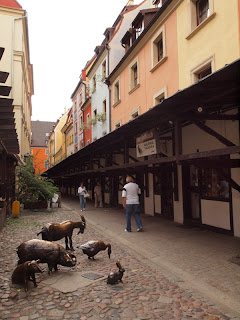At the end of the 14th century monks from Hungary
established a monastery at Częstochowa.
A Byzantine icon of the Virgin Mary was taken there and the shrine of
Jasna Gora established. It rapidly
became a major place of pilgrimage and today is visited by about five million
pilgrims each year. The icon is now at
the heart of a complex of beautiful churches, museums and associated
buildings. Although also visited by
thousands of tourists each year, Jasna Gora has maintained an air of reverence
and worship. And, to our surprise,
access to all the public buildings is free.
Surrounding the park outside are some interesting modern
sculptures representing the Stations of the Cross.
In Częstochowa itself, where there are eight universities,
we found other interesting sculptures some of which are suspended on wires.
From Częstochowa we headed east and south towards the
mountains and came to a lovely little town called Kazimierz Dolny on the Wisła
river.
We were able to cycle along the river bank promenade to go to the farmers’ market and visit the town.
We were able to cycle along the river bank promenade to go to the farmers’ market and visit the town.
Many of the buildings have roofs with long, narrow
interlocking wooden tiles.
On the Sunday morning the Market Place was filled with
spectators and dance groups from all over Europe taking part in an
International Folk Dance Festival
Continuing our journey we spent a night at Przeworsk (where
there be elephants!) ...
... before reaching Ustrzyki Gόrne, a village in the densely
forested Bieszczady National Park. Road
signs warn you to beware of bears but there are also wild boar, and lynx still
living there. From there we climbed 600
metres to the summit of Tarnica (1346m) on a hot, sunny day.
We had a great view from the top across the border with
Ukraine ...
... and managed to get back to the camp site before a
terrific thunder storm hit us.
We moved on to a very pleasant holiday resort beside a huge
reservoir at Solina, spoilt only by the dozens of cheap souvenir stalls, fast
food outlets and a fairground.
But these were almost invisible from the site.



















